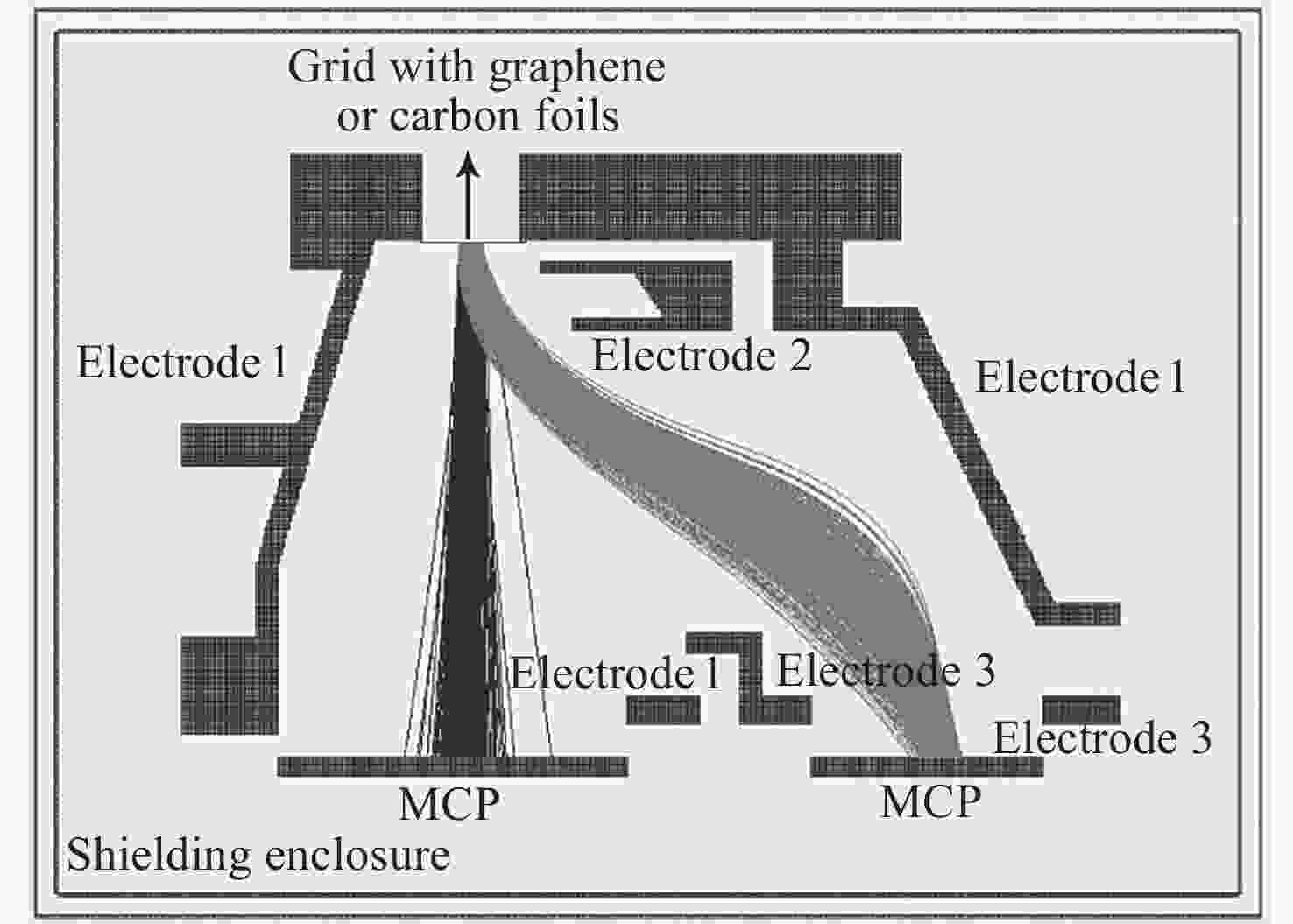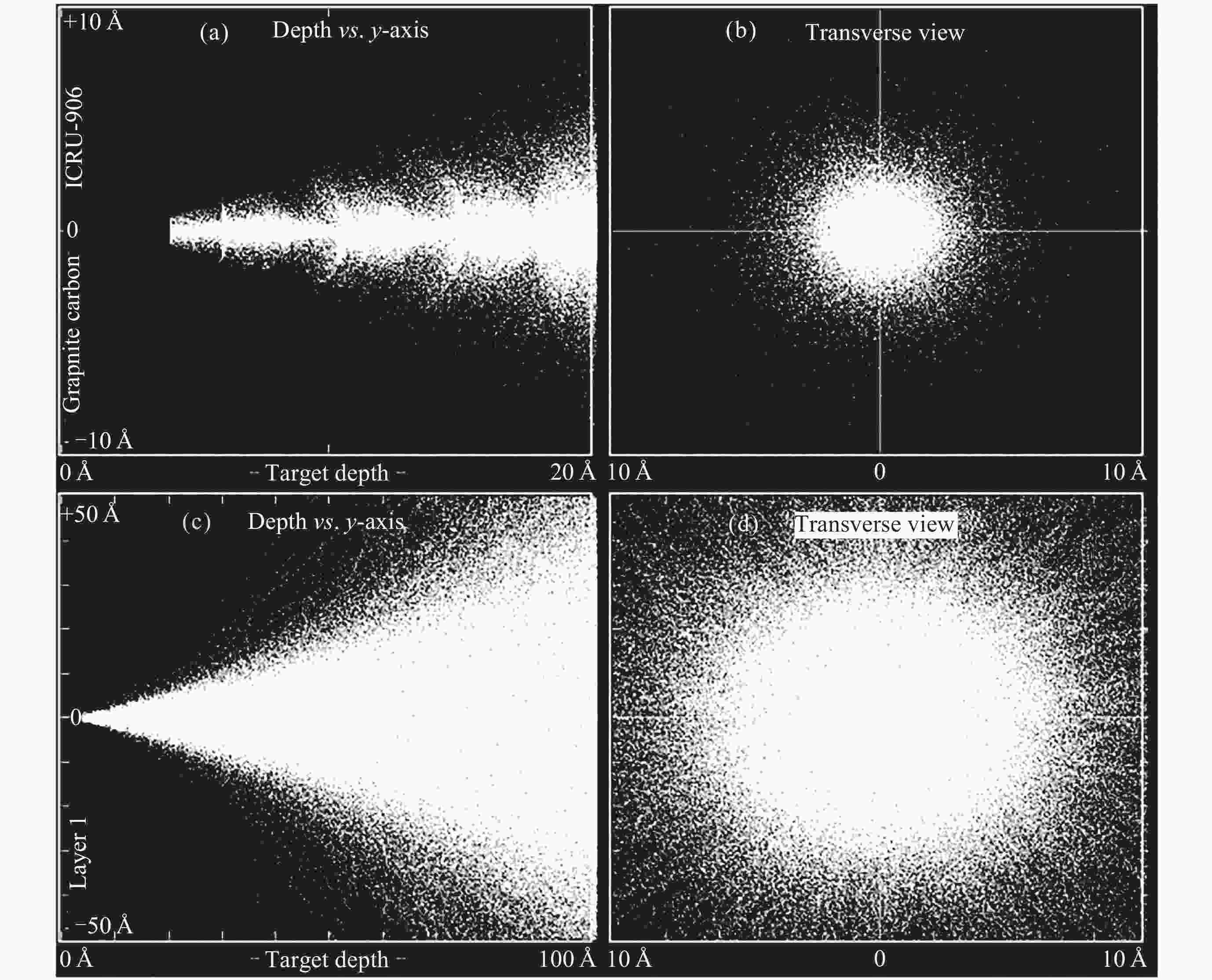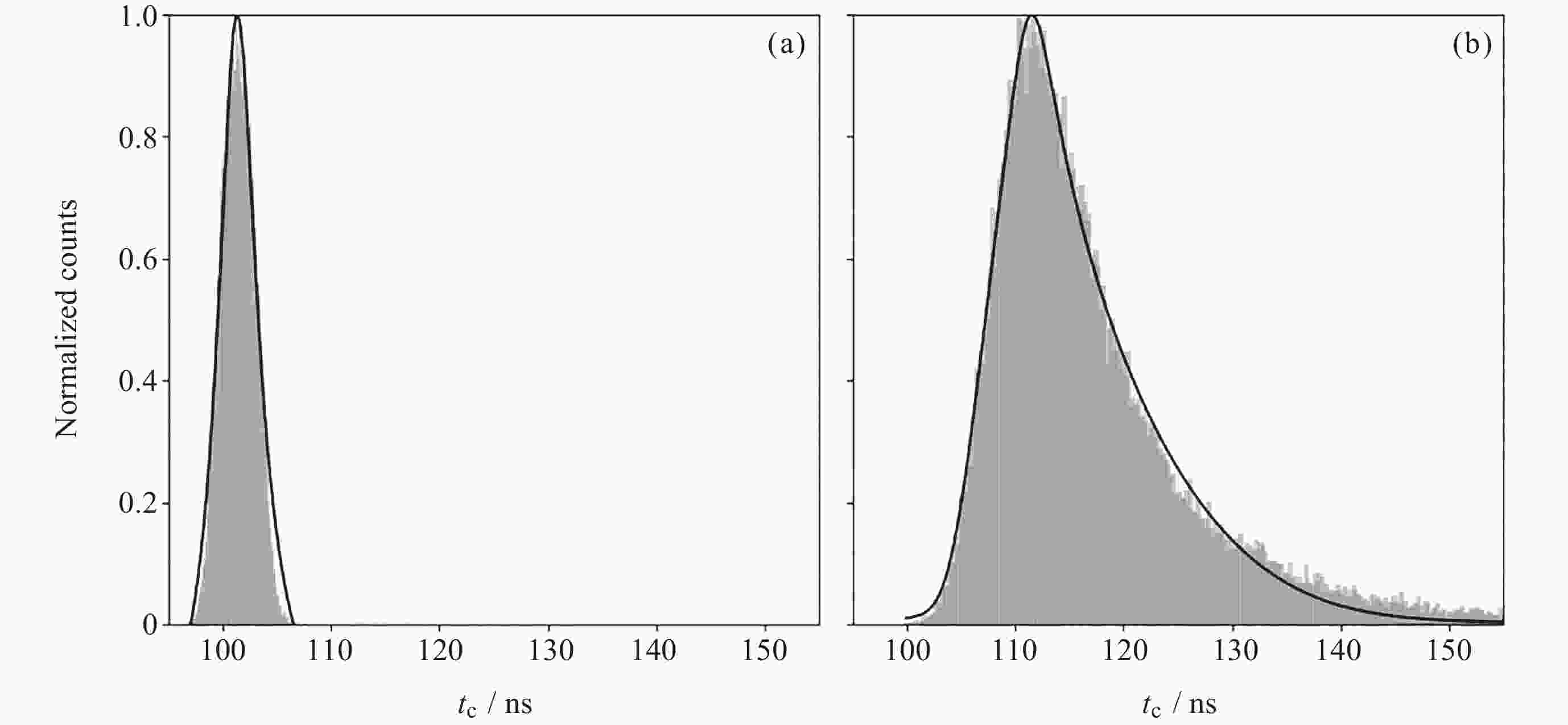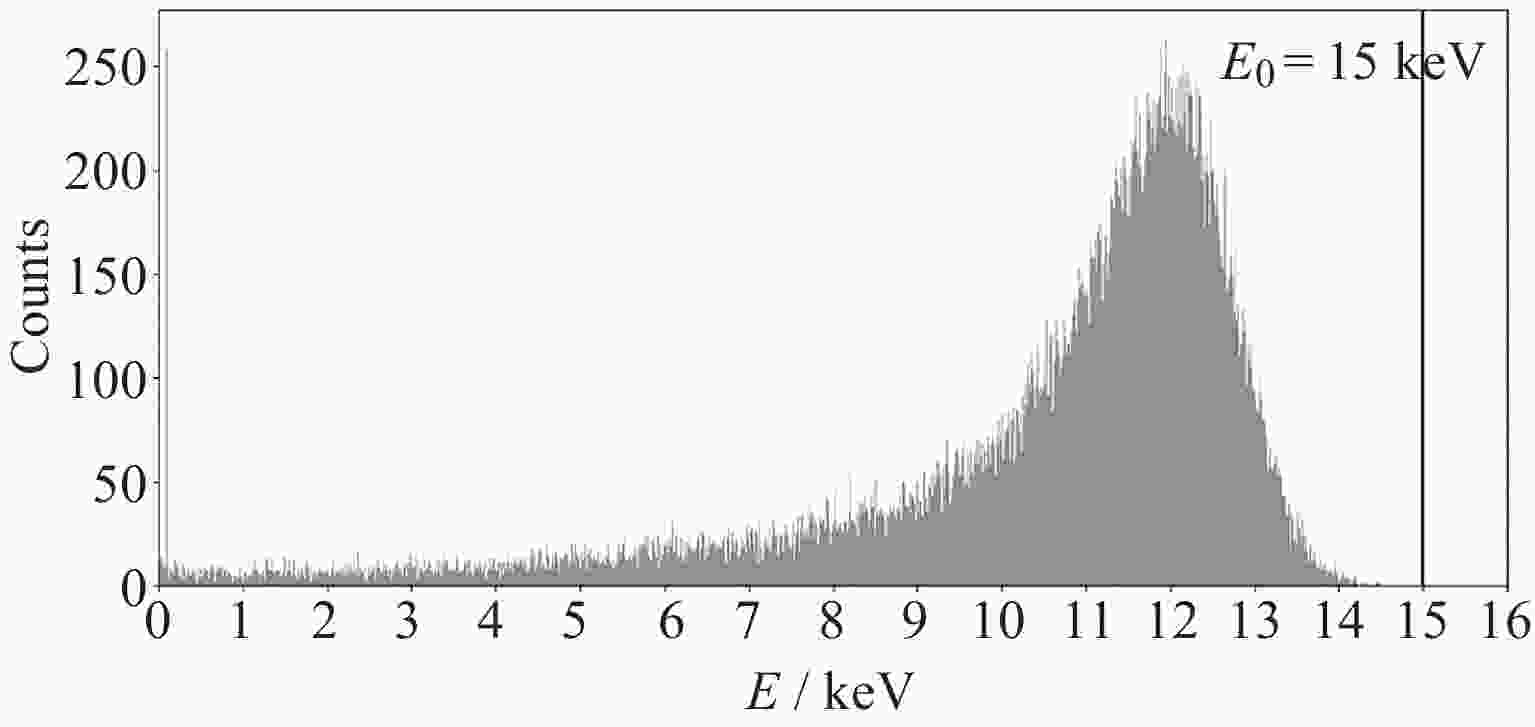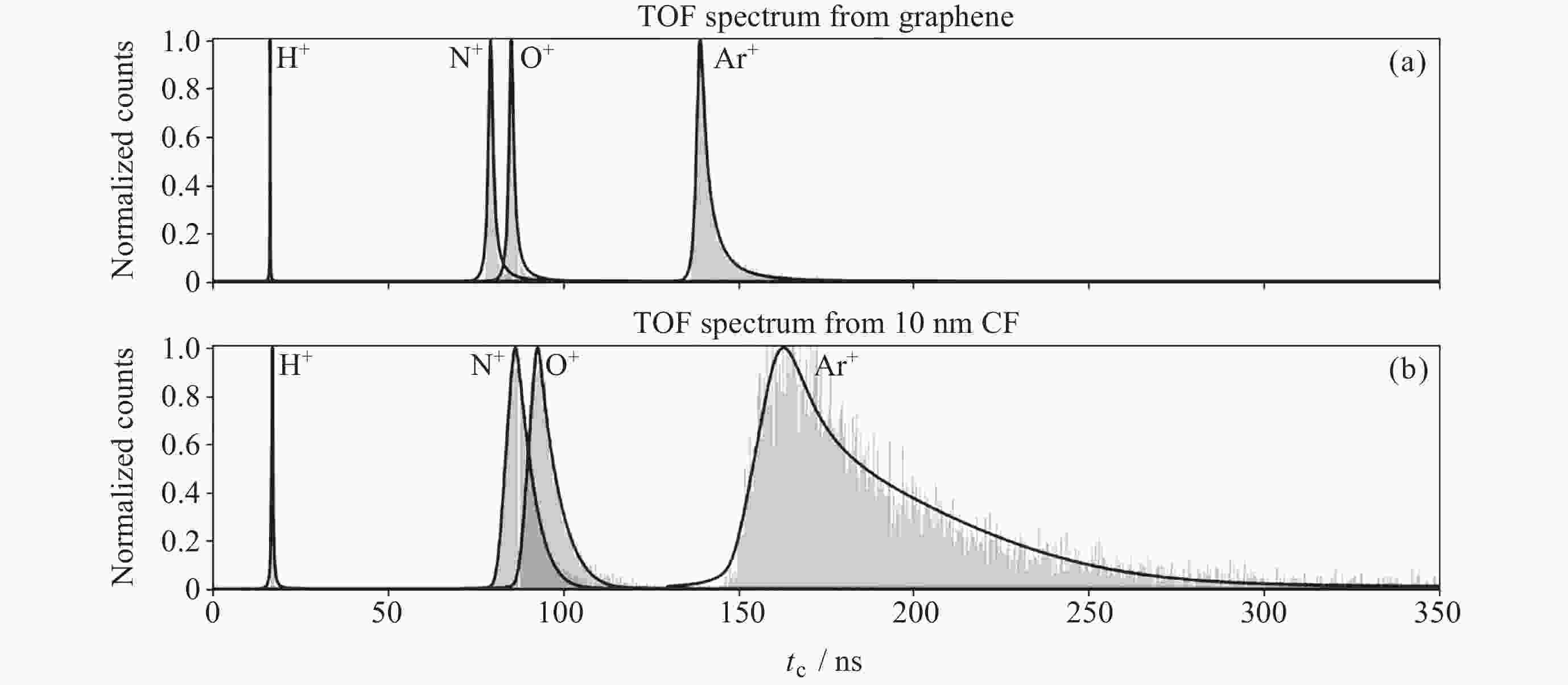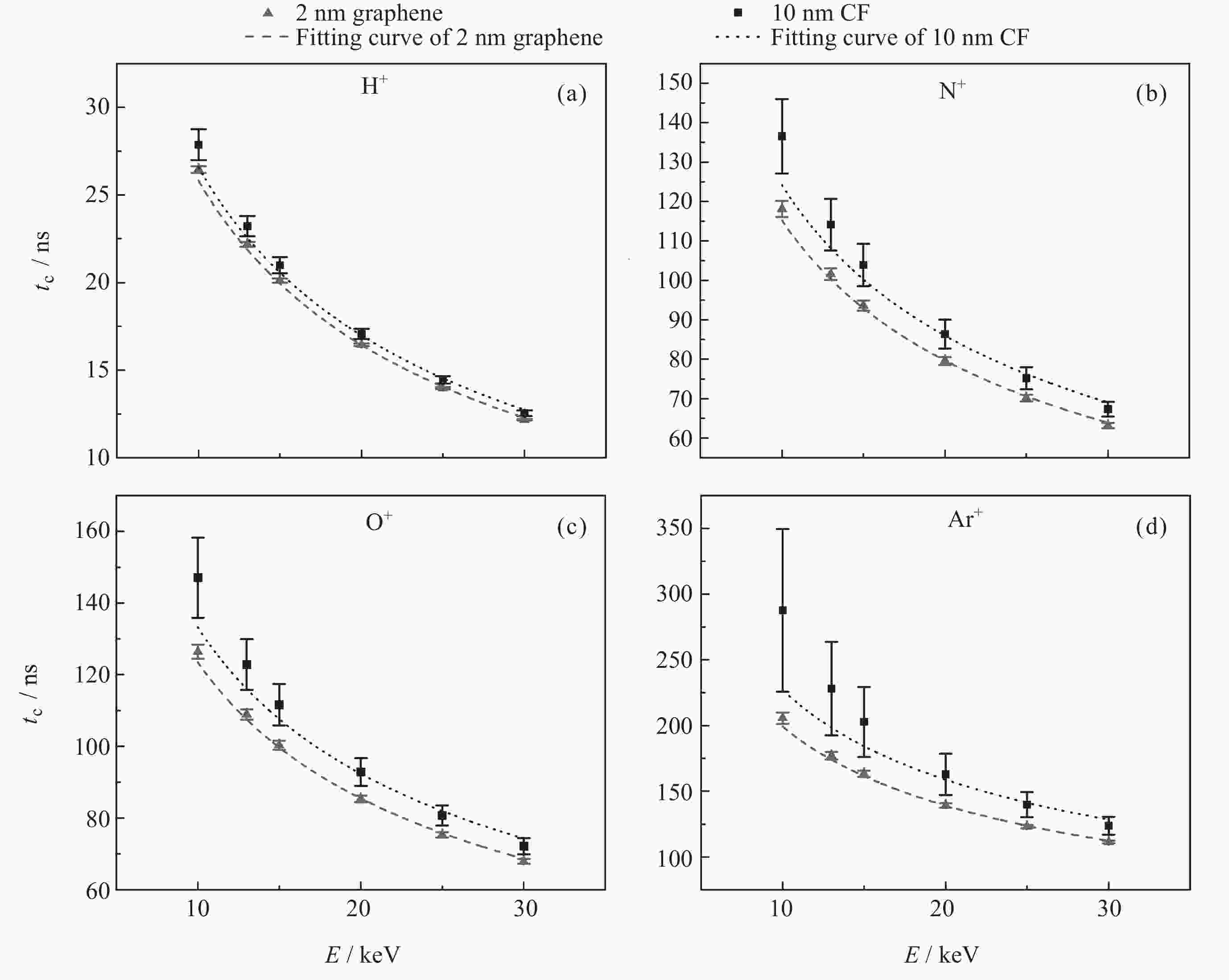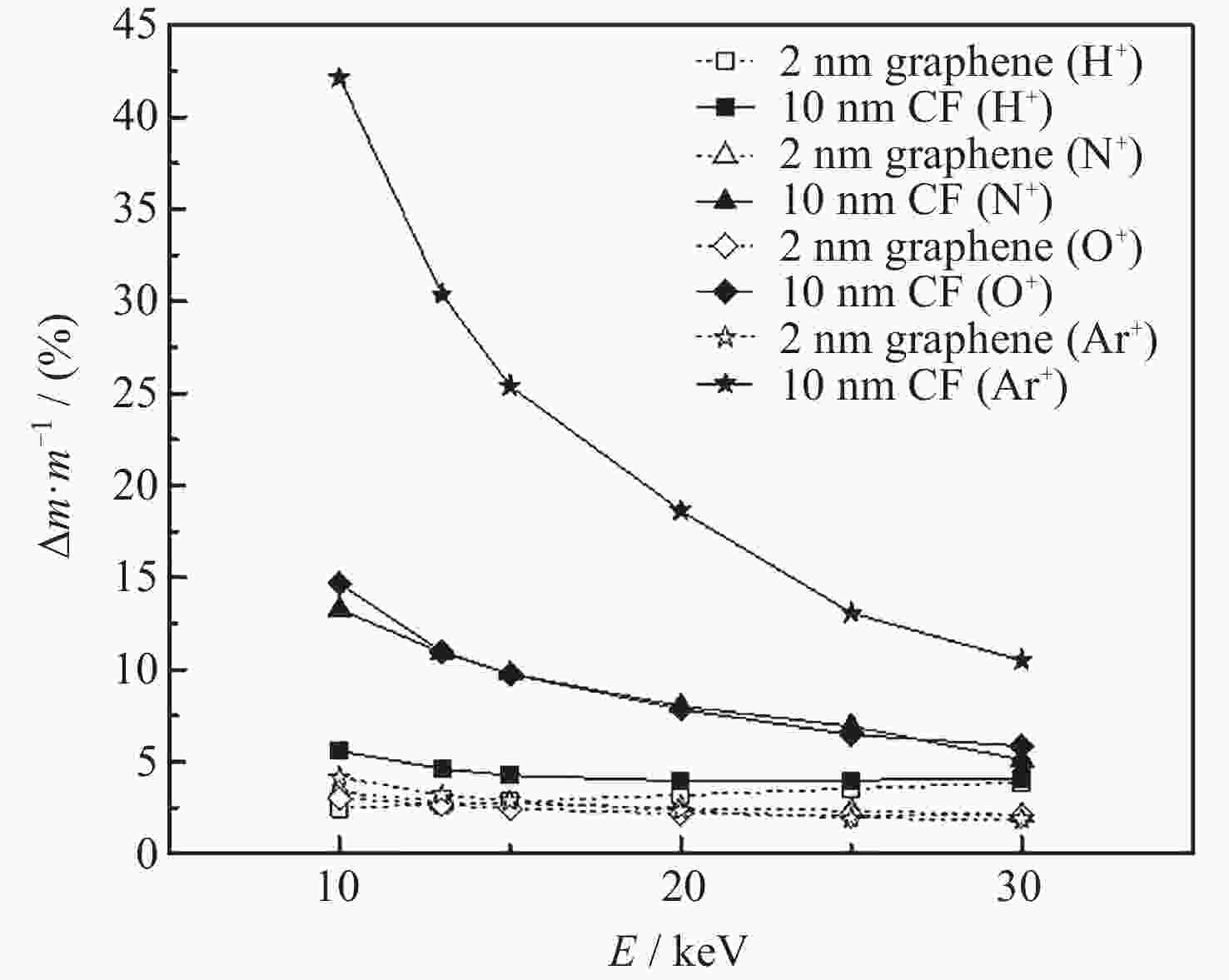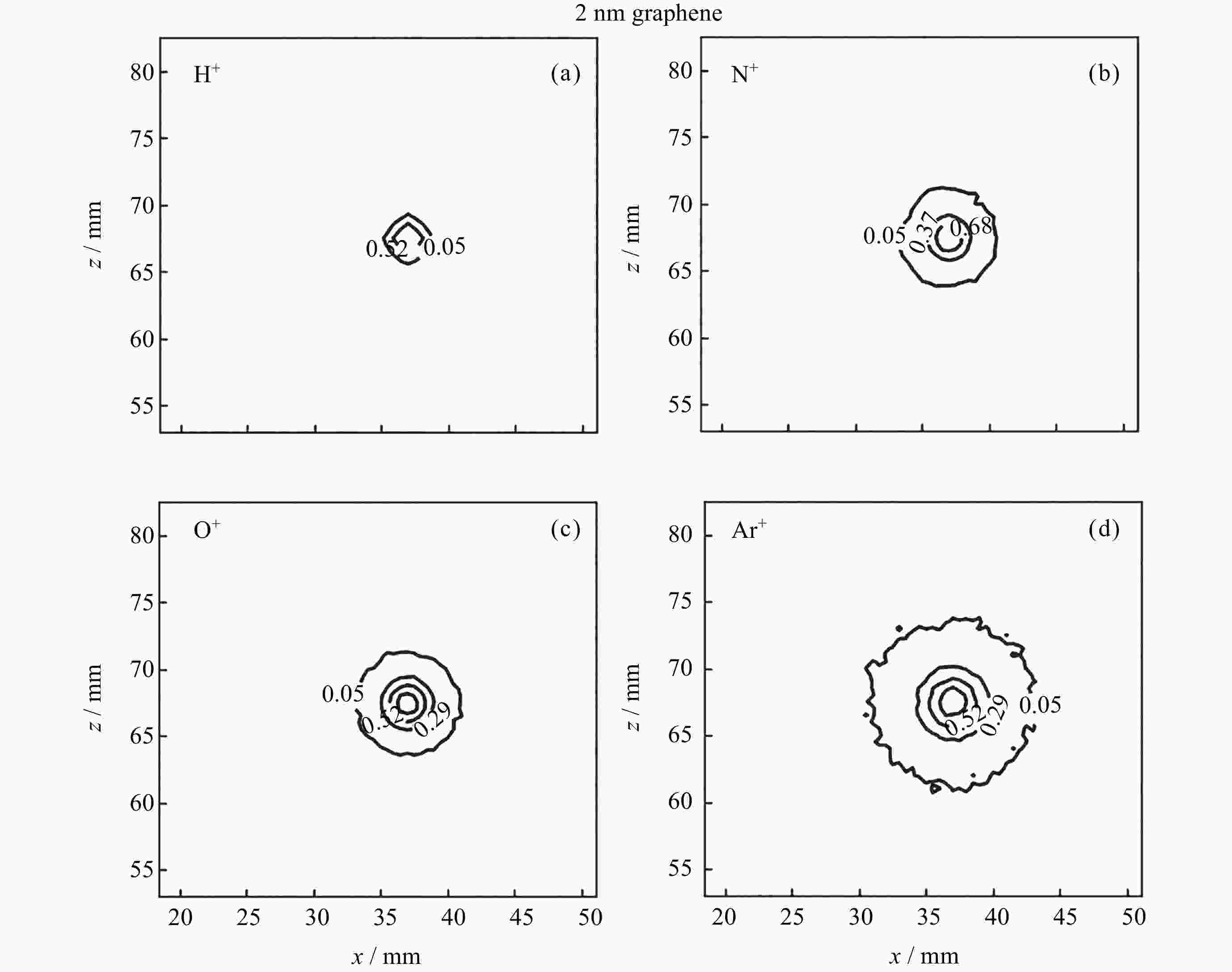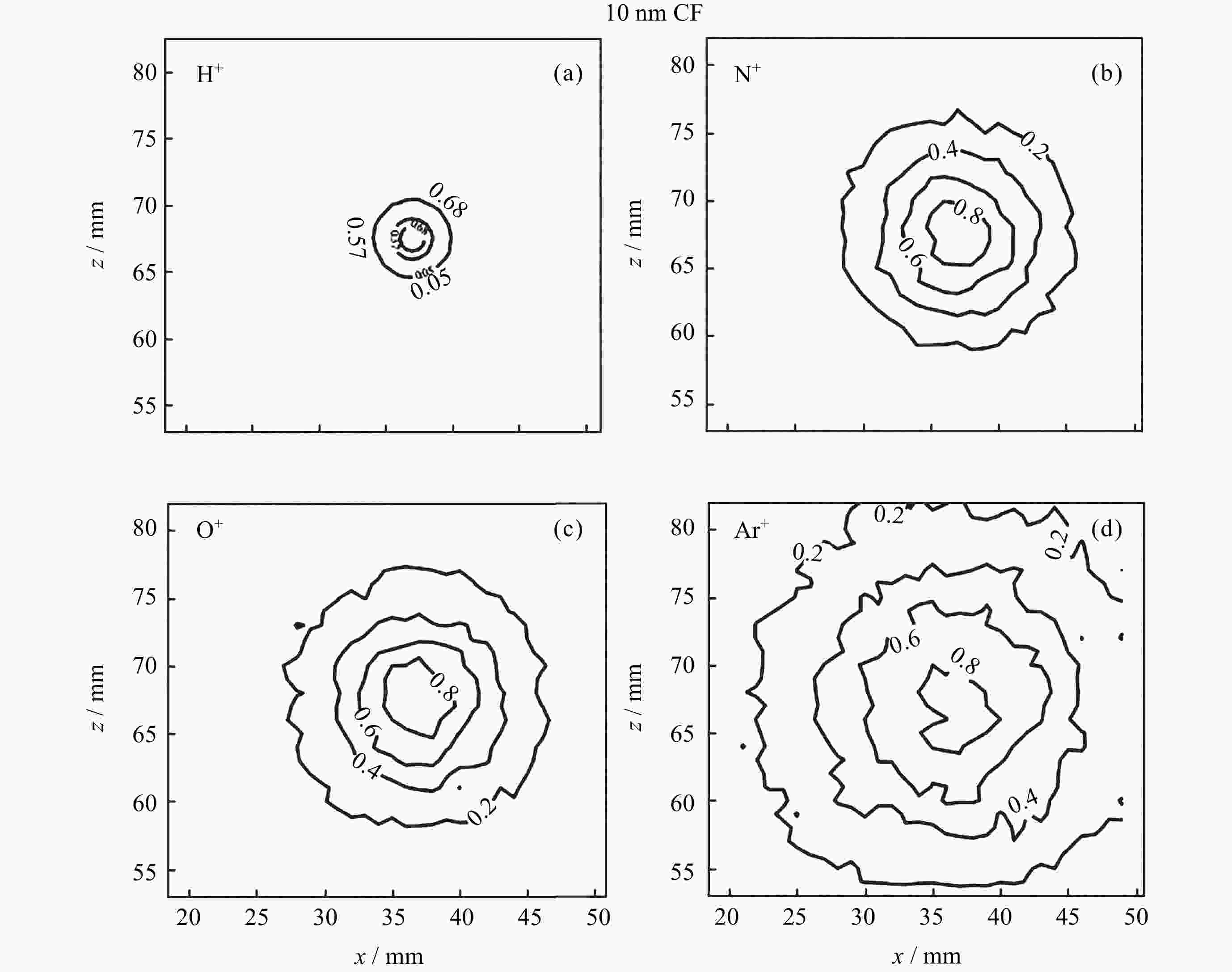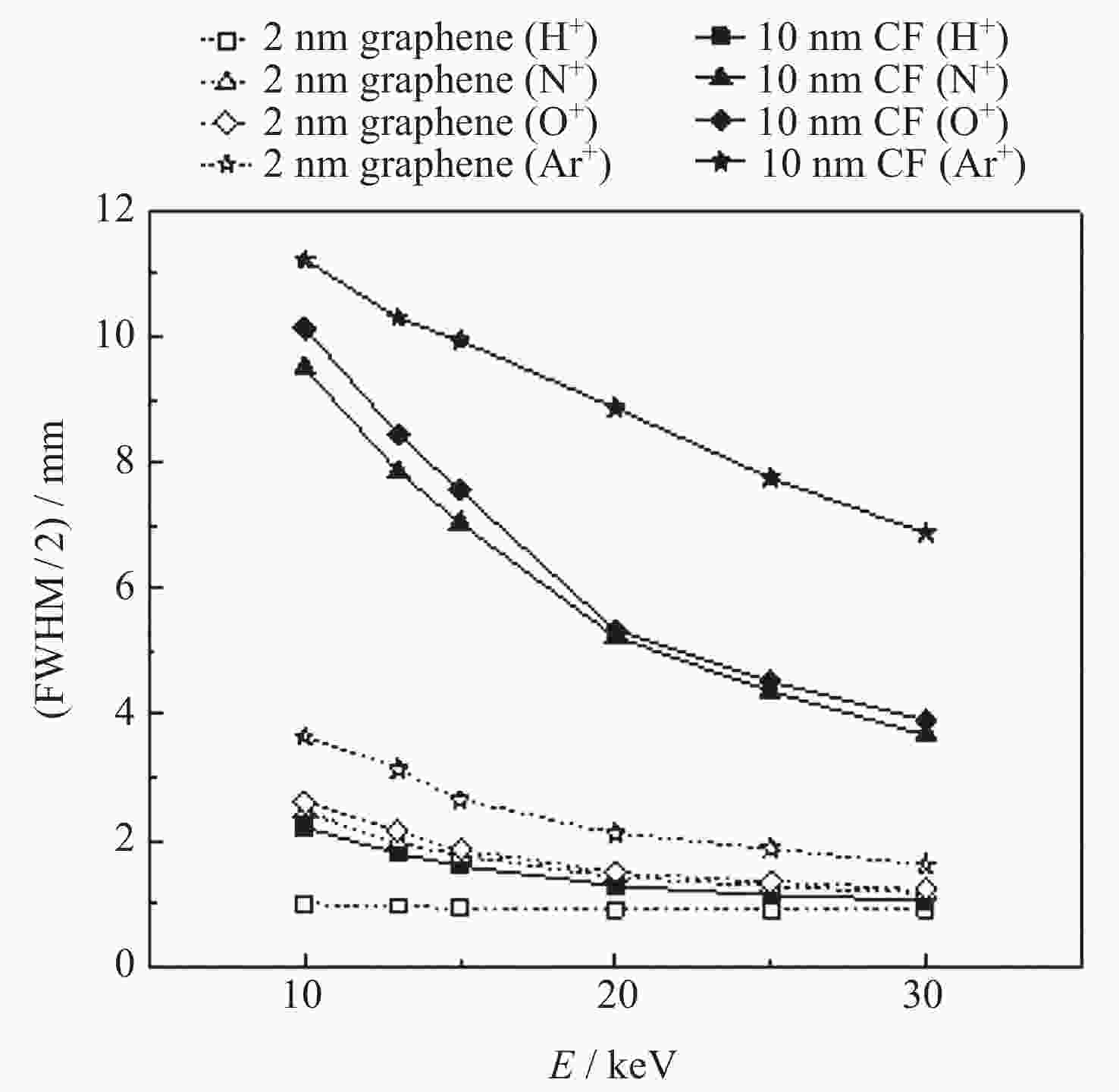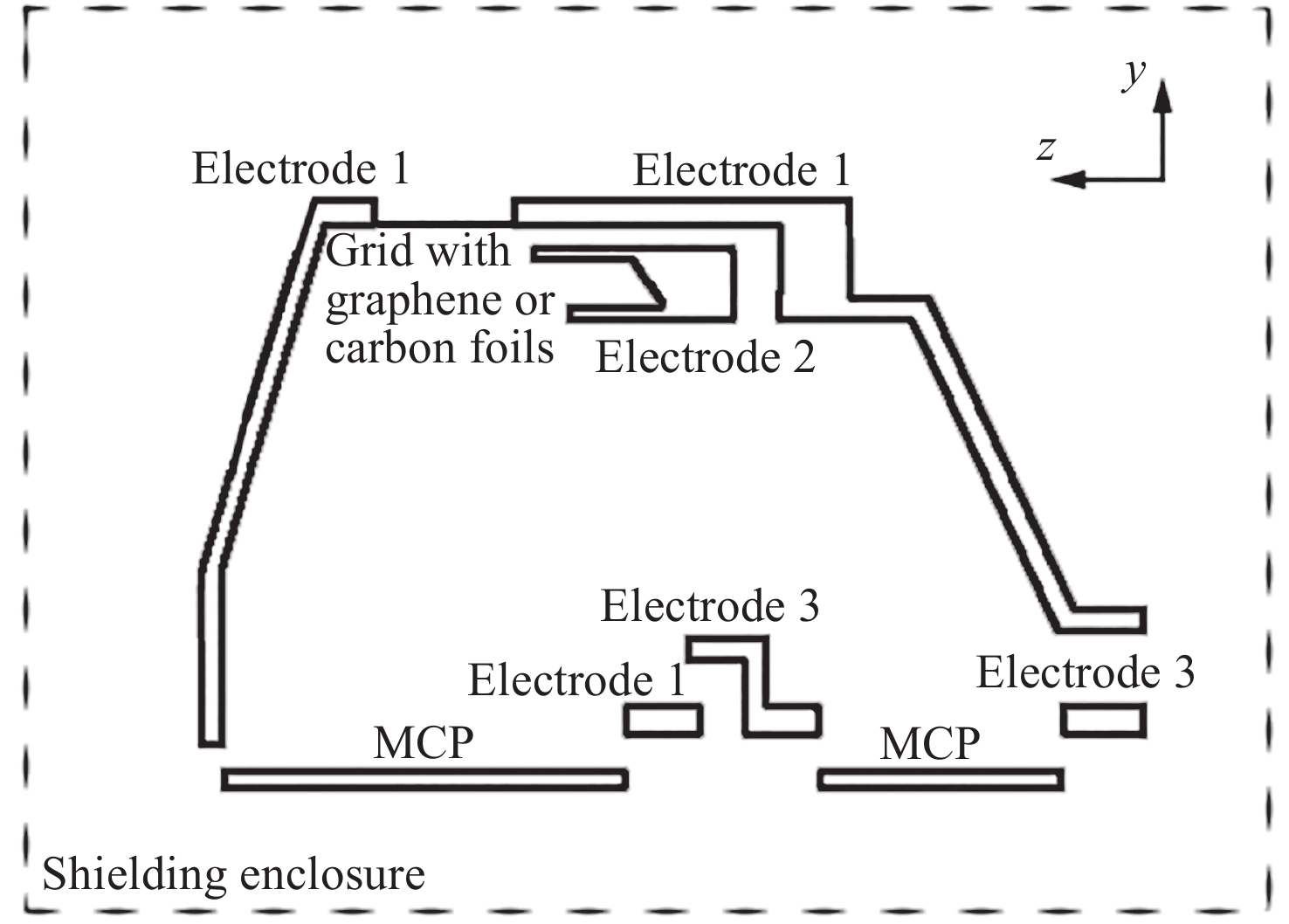A Comparative Simulation Study of Graphene and Carbon Foils in Satellite-borne TOF System
-
摘要: 在空间探测应用领域, 石墨烯薄膜因其低厚度特性, 成为一种受到研究者关注的新材料. 针对利用石墨烯薄膜替代碳膜作为星载薄膜式飞行时间(Time of Flight, TOF)系统中透射薄膜材料的应用情景, 采用粒子透射仿真软件SRIM和粒子光学仿真软件SIMION进行联用的方法, 进行石墨烯薄膜和碳膜在TOF系统中具体表现的计算机仿真模拟, 得到了飞行时间谱图、散斑分布与散角、探测效率等指标的对比结果. 仿真结果表明, 应用于星载TOF系统的石墨烯薄膜相比碳膜表现出更好的质谱分辨、更小的散斑半径和散角以及更高的探测效率, 表明使用石墨烯薄膜替代碳膜可明显提升薄膜式TOF系统的性能. 对该结论的进一步证明则需要对应的实验测试数据和结果. 相关结果可为后续对石墨烯薄膜进行实际测试以及其他相关研究提供参考.Abstract: Recently, graphene foils are considered a promising material for space detection applications due to their minimal thickness. For comparing the specific performance of graphene and carbon foils in film-type Time-of-Flight (TOF) systems, a detailed computer simulation in a definite TOF system is conducted by integrating SRIM, the particle transmission simulation software, with SIMION, the particle optical simulation software. TOF simulation results focused on various aspects of TOF system performance are obtained, such as TOF spectra, scattering distribution, scattering angle, and detection efficiency. These parameters of the TOF system provide reference to the ability of mass spectrometric differentiation and simulation results show that graphene foils applied to the satellite-borne TOF system have higher spectral resolution, shorter scattering radius, lower scattering angle, and higher detection efficiency compared to carbon foils. Graphene’s better performance is derived from its lower thickness, which causes less scattering during ion transmission into graphene. These findings indicate that using graphene foils instead of carbon foils can improve the performance of film-type TOF systems. Further validation of this conclusion requires corresponding experimental test data and results. The conclusion can be referred to the practical testing of graphene foils and other related research, which can make progress for the final practical facilitation of graphene on in-flight TOF systems.
-
Key words:
- Space particle detection /
- Film-type TOF system /
- Carbon foils /
- Graphene /
- SRIM /
- SIMION
-
图 3 20 keV Ar+在石墨烯薄膜和碳膜中散射的SRIM仿真结果. (a)石墨烯薄膜的侧面视角, (b)石墨烯薄膜的背面视角, (c)碳膜的侧面视角, (d)碳膜的背面视角. (a)(c)横坐标为薄膜深度, 纵坐标为与入射点的水平偏移; (b)(d)坐标平面为与薄膜平行的平面, 白点分布为入射粒子轨迹分布
Figure 3. SRIM results of 20 keV Ar+ scattering in graphene and carbon foils. (a) Side view of graphene, (b) back view of graphene, (c) side view of carbon foil, (d) back view of carbon foil. In (a) and (c), the horizontal axis represents film depth and the vertical axis shows horizontal offset from the incident point. In (b) and (d), the coordinate plane is parallel to the film surface, with white dots indicating the distribution of incident particle trajectories
表 1 由两种仿真方法和文献[7]实测数据得到的tc的对比
Table 1. Comparison of tc derived from two simulation methods and experimental data in Ref. [7]
方法 tc (H+) /ns tc (O+) /ns tc (${\mathrm{O}}_2^+ $) /ns tc (${\mathrm{CO}}_2^+ $) /ns 文献值 16.56 79.13 129.25 148.88 联用方法值* 14.36 76.37 117.58 145.10 单用方法值* 14.19 69.40 - - 注 联用方法值和单用方法值的tc是通过式(1)消除了不同的d和E的影响得到的. 由于缺乏相关文献数据进行初始设置, 单用方法无法对${\mathrm{O}}_2^+ $和${\mathrm{CO}}_2^+ $进行仿真, 因此数据暂缺. 离子种类 石墨烯薄膜 碳膜 tc /ns FWHM /ns tc /ns FWHM /ns H+ 16.45 0.14 17.07 0.59 N+ 79.55 1.99 86.36 7.37 O+ 85.35 1.84 92.87 7.72 Ar+ 139.20 3.29 162.88 31.49 表 3 拟合反演相对原子质量的结果对比
Table 3. Contrast of derived relative atomic mass
离子种类 真实值/u 石墨烯薄膜反演结果/u 碳膜反演结果/u H+ 1.01 1.02 1.07 N+ 14.01 14.69 16.93 O+ 16.00 16.76 19.38 Ar+ 39.95 42.05 54.23 注 u为相对原子质量单位, 1 u为碳原子质量的1/12, 即1 u=1.66×10–27 kg. 表 4 离子穿透石墨烯薄膜和碳膜后的散角
Table 4. Scattering angle of ions through graphene and carbon foils
E/keV H+ N+ O+ Ar+ 石墨烯薄膜/(°) 碳膜/(°) 石墨烯薄膜/(°) 碳膜/(°) 石墨烯薄膜/(°) 碳膜/(°) 石墨烯薄膜/(°) 碳膜/(°) 10 5.17 11.47 12.80 48.74 13.56 51.91 19.00 57.24 13 5.00 9.33 10.23 40.50 11.20 43.47 16.30 52.70 15 4.81 8.30 9.15 36.37 9.69 38.98 13.76 50.94 20 4.70 6.68 7.45 27.15 7.74 27.71 11.01 45.59 25 4.66 5.86 6.64 22.68 7.01 23.48 9.77 40.00 30 4.65 5.46 6.09 19.09 6.33 20.31 8.41 35.55 表 5 离子对石墨烯薄膜和碳膜的透过率
Table 5. Transmitting efficiency of ions through graphene and carbon foils
E/keV H+ N+ O+ Ar+ 石墨烯薄膜/(%) 碳膜/% 石墨烯薄膜/(%) 碳膜/% 石墨烯薄膜/(%) 碳膜/(%) 石墨烯薄膜/(%) 碳膜/(%) 10 99.98 99.94 99.91 94.53 99.93 92.90 99.99 69.87 13 99.99 99.95 99.96 97.38 99.98 96.48 99.99 85.38 15 99.99 99.96 99.98 98.14 99.98 97.68 100 90.99 20 99.99 99.98 99.98 99.24 99.99 99.07 100 96.96 25 99.99 99.99 99.99 99.61 99.99 99.52 100 98.85 30 99.99 99.99 99.99 99.78 99.99 99.72 100 99.52 表 6 离子穿透石墨烯薄膜和碳膜后的TOF系统收集效率
Table 6. TOF system collecting efficiency of ions through graphene and carbon foils
E/keV H+ N+ O+ Ar+ 石墨烯薄膜/(%) 碳膜/(%) 石墨烯薄膜/(%) 碳膜/(%) 石墨烯薄膜/(%) 碳膜/(%) 石墨烯薄膜/(%) 碳膜/(%) 10 99.74 98.27 93.83 61.72 93.08 57.08 91.95 25.39 13 99.83 99.08 95.97 73.05 95.49 69.22 95.52 43.16 15 99.88 99.29 96.96 78.27 96.37 74.47 96.78 52.45 20 99.94 99.61 97.88 86.16 97.71 83.84 98.17 68.18 25 99.96 99.74 98.63 90.61 98.49 88.91 98.81 77.59 30 99.96 99.81 99.03 93.11 98.80 91.87 99.26 84.01 表 7 灵敏度比值和计数相对误差比值
Table 7. Ratio of sensitivity and ratio of relative count error
E/keV H+ N+ O+ Ar+ GC/GG/(%) δG/δC/(%) GC/GG/(%) δG/δC/(%) GC/GG/(%) δG/δC/(%) GC/GG/(%) δG/δC/(%) 10 98.49 99.24 62.23 78.89 57.01 75.50 19.29 43.92 13 99.21 99.60 74.15 86.11 69.95 83.64 38.58 62.11 15 99.38 99.69 79.24 89.02 75.50 86.89 49.31 70.22 20 99.65 99.83 87.37 93.47 85.02 92.20 67.34 82.06 25 99.77 99.89 91.52 95.67 89.84 94.78 77.62 88.10 30 99.84 99.92 93.82 96.86 92.73 96.30 84.23 91.78 -
[1] RÈME H, BOSQUED J M, SAUVAUD J A, et al. The cluster ion spectrometry (CIS) experiment[J]. Space Science Reviews, 1997, 79(1): 303-350 [2] YOUNG D T, BARRACLOUGH B L, BERTHELIER J J, et al. Cassini plasma spectrometer investigation[C]//Cassini/Huygens: A Mission to the Saturnian Systems. Denver: SPIE, 1996, 2803: 118-128 [3] SAITO Y, YOKOTA S, ASAMURA K, et al. In-flight performance and initial results of plasma energy angle and composition experiment (PACE) on SELENE (Kaguya)[J]. Space Science Reviews, 2010, 154(1/2/3/4): 265-303 [4] MCCOMAS D, ALLEGRINI F, BAGENAL F, et al. The solar wind around Pluto (SWAP) instrument aboard New horizons[J]. Space Science Reviews, 2008, 140(1/2/3/4): 261-313 [5] LI L, WANG S J, ZHANG A B, et al. The plasma experiment of the YH-1 mission[C]//Seventh International Symposium on Instrumentation and Control Technology: Optoelectronic Technology and Instruments, Control Theory and Automation, and Space Exploration. Beijing: SPIE, 2008, 7129: 71292P [6] OWEN C J, BRUNO R, LIVI S, et al. The solar orbiter solar wind analyser (SWA) suite[J]. Astronomy :Times New Roman;">& Astrophysics, 2020, 642: A16 [7] KONG L G, ZHANG A B, TIAN Z, et al. Mars ion and neutral particle analyzer (MINPA) for Chinese mars exploration mission (Tianwen-1): design and ground calibration[J]. Earth and Planetary Physics, 2020, 4(4): 333-344 [8] 孔令高, 苏斌, 关燚炳, 等. 行星等离子体探测技术[J]. 地球与行星物理论评, 2021, 52(5): 459-472KONG Linggao, SU Bin, GUAN Yibing, et al. Planetary plasma measurement technology[J]. Reviews of Geophysics and Planetary Physics, 2021, 52(5): 459-472 [9] FUNSTEN H O, SKOUG R M, GUTHRIE A A, et al. Helium, oxygen, proton, and electron (HOPE) mass spectrometer for the radiation belt storm probes mission[J]. Space Science Reviews, 2013, 179(1/2/3/4): 423-484 [10] FUSELIER S A, BOCHSLER P, CHORNAY D, et al. The IBEX-Lo sensor[J]. Space Science Reviews, 2009, 146(1/2/3/4): 117-147 [11] MCCOMAS D J, ALEXANDER N, ALLEGRINI F, et al. The Jovian Auroral distributions experiment (JADE) on the Juno Mission to Jupiter[J]. Space Science Reviews, 2017, 213(1/2/3/4): 547-643 [12] DELCOURT D, SAITO Y, LEBLANC F, et al. The mass spectrum analyzer (MSA) on board the BepiColombo MMO[J]. Journal of Geophysical Research: Space Physics, 2016, 121(7): 6749-6761 doi: 10.1002/2016JA022380 [13] MCFADDEN J P, KORTMANN O, CURTIS D, et al. MAVEN SupraThermal and thermal ion compostion (STATIC) instrument[J]. Space Science Reviews, 2015, 195(1/2/3/4): 199-256 [14] MCCOMAS D J, ALLEGRINI F, BALDONADO J, et al. The two wide-angle imaging neutral-atom spectrometers (TWINS) NASA mission-of-opportunity[J]. Space Science Reviews, 2009, 142(1/2/3/4): 157-231 [15] 孔令高, 张爱兵, 田峥, 等. 自主火星探测高集成离子与中性粒子分析仪[J]. 深空探测学报, 2019, 6(2): 142-149KONG Linggao, ZHANG Aibing, TIAN Zheng, et al. Integrated ion and neutral particle analyzer for Chinese Mars mission[J]. Journal of Deep Space Exploration, 2019, 6(2): 142-149 [16] EBERT R W, ALLEGRINI F, FUSELIER S A, et al. Angular scattering of 1–50 keV ions through graphene and thin carbon foils: potential applications for space plasma instrumentation[J]. Review of Scientific Instruments, 2014, 85(3): 033302 doi: 10.1063/1.4866850 [17] ALLEGRINI F, EBERT R W, NICOLAOU G, et al. Semi-empirical relationships for the energy loss and straggling of 1–50 keV hydrogen ions passing through thin carbon foils[J]. Nuclear Instruments and Methods in Physics Research Section B: Beam Interactions with Materials and Atoms, 2015, 359: 115-119 [18] ALLEGRINI F, EBERT R W, FUNSTEN H O. Carbon foils for space plasma instrumentation[J]. Journal of Geophysical Research: Space Physics, 2016, 121(5): 3931-3950 doi: 10.1002/2016JA022570 [19] ALLEGRINI F, DAYEH M A. Thin carbon foil resistance to differential pressure[J]. Vacuum, 2014, 107: 124-128 doi: 10.1016/j.vacuum.2014.04.020 [20] NOVOSELOV K S, GEIM A K, MOROZOV S V, et al. Electric field effect in atomically thin carbon films[J]. Science, 2004, 306(5696): 666-669 doi: 10.1126/science.1102896 [21] LEE C, WEI X D, KYSAR J W, et al. Measurement of the elastic properties and intrinsic strength of monolayer graphene[J]. Science, 2008, 321(5887): 385-388 doi: 10.1126/science.1157996 [22] ALLEGRINI F, EBERT R W, FUSELIER S A, et al. Charge state of ∼1 to 50 keV ions after passing through graphene and ultrathin carbon foils[J]. Optical Engineering, 2014, 53(2): 024101 doi: 10.1117/1.OE.53.2.024101 [23] ALLEGRINI F, BEDWORTH P, EBERT R W, et al. Energy loss and straggling of 1~50 keV H, He, C, N, and O ions passing through few layer graphene[J]. Nuclear Instruments and Methods in Physics Research Section B: Beam Interactions with Materials and Atoms, 2015, 358: 223-228 [24] OLABI A G, ABDELKAREEM M A, WILBERFORCE T, et al. Application of graphene in energy storage device–a review[J]. Renewable and Sustainable Energy Reviews, 2021, 135: 110026 doi: 10.1016/j.rser.2020.110026 [25] WU H Q, LINGHU C Y, LU H M, et al. Graphene applications in electronic and optoelectronic devices and circuits[J]. Chinese Physics B, 2013, 22(9): 098106 doi: 10.1088/1674-1056/22/9/098106 [26] ZHONG Y J, ZHEN Z, ZHU H W. Graphene: fundamental research and potential applications[J]. FlatChem, 2017, 4: 20-32 doi: 10.1016/j.flatc.2017.06.008 [27] 孔令高, 张爱兵, 郑香脂, 等. 热离子质谱分析仪的研制及定标[J]. 空间科学学报, 2017, 37(5): 585-592 doi: 10.11728/cjss2017.05.585KONG Linggao, ZHANG Aibing, ZHENG Xiangzhi, et al. Development and calibration of thermal ion mass spectrometer[J]. Chinese Journal of Space Science, 2017, 37(5): 585-592 doi: 10.11728/cjss2017.05.585 [28] ZEIGER B R, SHIELDS M W, PAUL B, et al. Graphene foils for neutral atom detectors[C]//Earth Observing Systems XXIV. San Diego: SPIE, 2019, 11127: 111272C [29] VIRA A D, FERNANDES P A, FUNSTEN H O, et al. Angular scattering of protons through ultrathin graphene foils: application for time-of-flight instrumentation[J]. Review of Scientific Instruments, 2020, 91(3): 033302 doi: 10.1063/1.5134768 [30] 孔令高, 张爱兵, 王世金, 等. 基于SIMION软件的空间等离子体探测器的数值仿真[J]. 中国空间科学技术, 2012, 32(4): 71-76KONG Linggao, ZHANG Aibing, WANG Shijin, et al. Numerical simulation analysis of space plasma detector based on SIMION[J]. Chinese Space Science and Technology, 2012, 32(4): 71-76 [31] GALVIN A B, KISTLER L M, POPECKI M A, et al. The plasma and suprathermal ion composition (PLASTIC) investigation on the STEREO observatories[J]. Space Science Reviews, 2008, 136(1): 437-486 [32] KONG L G, ZHANG A B, ZHENG X Z, et al. A satellite-borne miniature ion mass spectrometer for space plasma[J]. Chinese Journal of Space Science, 2015, 35(6): 755-762 doi: 10.11728/cjss2015.06.755 [33] MCCOMAS D J, ALLEGRINI F, POLLOCK C J, et al. Ultrathin (∼10 nm) carbon foils in space instrumentation[J]. Review of Scientific Instruments, 2004, 75(11): 4863-4870 doi: 10.1063/1.1809265 [34] ZIEGLER J F, ZIEGLER M D, BIERSACK J P. SRIM–the stopping and range of ions in matter (2010)[J]. Nuclear Instruments and Methods in Physics Research Section B: Beam Interactions with Materials and Atoms, 2010, 268(11/12): 1818-1823 [35] DAHL D A. SIMION for the personal computer in reflection[J]. International Journal of Mass Spectrometry, 2000, 200(1/2/3): 3-25 [36] DIB A, AMMI H, MSIMANGA M, et al. Stopping force of (0.09–0.30) MeV/n 22Ti, 24Cr and 28Ni ions in aluminum oxide and titanium oxide thin foils by time of flight spectrometry[J]. Nuclear Instruments and Methods in Physics Research Section B: Beam Interactions with Materials and Atoms, 2023, 543: 165099 doi: 10.1016/j.nimb.2023.165099 [37] YIĞIT M, KARA A, YILMAZ A. A study on interactions of 14.7 MeV protons and 3.6 MeV Alphas in 93Nb target[J]. Fusion Science and Technology, 2024, 80(2): 156-165 doi: 10.1080/15361055.2023.2211190 [38] 孙立涛, 徐涛, 尹奎波. 石墨烯及相关二维材料显微结构表征[M]. 北京: 化学工业出版社, 2018SUN Litao, XU Tao, YIN Kuibo. Microstructural Characterization of Graphene and Related 2D Materials[M]. Beijing: Chemical Industry Press, 2018 [39] WANG C Y, XING Y W, LEI Y Z, et al. Adsorption of water on carbon materials: the formation of “water bridge” and its effect on water adsorption[J]. Colloids and Surfaces A: Physicochemical and Engineering Aspects, 2021, 631: 127719 doi: 10.1016/j.colsurfa.2021.127719 [40] STANCIK A L, BRAUNS E B. A simple asymmetric lineshape for fitting infrared absorption spectra[J]. Vibrational Spectroscopy, 2008, 47(1): 66-69 doi: 10.1016/j.vibspec.2008.02.009 [41] WÜEST M, EVANS D S, VON STEIGER R. Calibration of Particle Instruments in Space Physics[M]. Noordwijk: The International Space Science Institute, 2007. -
-





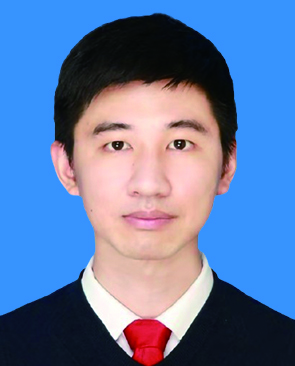 徐鹏晖 男, 1996年10月出生于湖南省常德市, 现为中国科学院国家空间科学中心博士研究生, 主要从事空间粒子辐射探测、星载飞行时间系统的仿真与测试等方面的研究. E-mail:
徐鹏晖 男, 1996年10月出生于湖南省常德市, 现为中国科学院国家空间科学中心博士研究生, 主要从事空间粒子辐射探测、星载飞行时间系统的仿真与测试等方面的研究. E-mail: 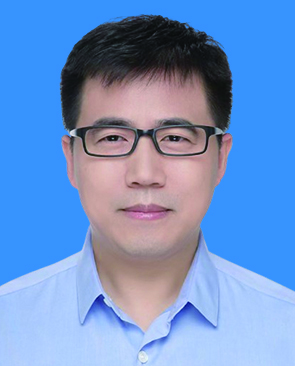 张爱兵 男, 博士, 研究员, 主要从事空间探测技术研究及载荷研制方面的研究. E-mail:
张爱兵 男, 博士, 研究员, 主要从事空间探测技术研究及载荷研制方面的研究. E-mail:  麻继杰 男, 博士研究生, 主要从事火星空间环境粒子探测数据分析方面的研究. E-mail:
麻继杰 男, 博士研究生, 主要从事火星空间环境粒子探测数据分析方面的研究. E-mail: 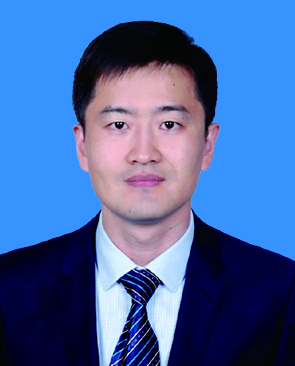
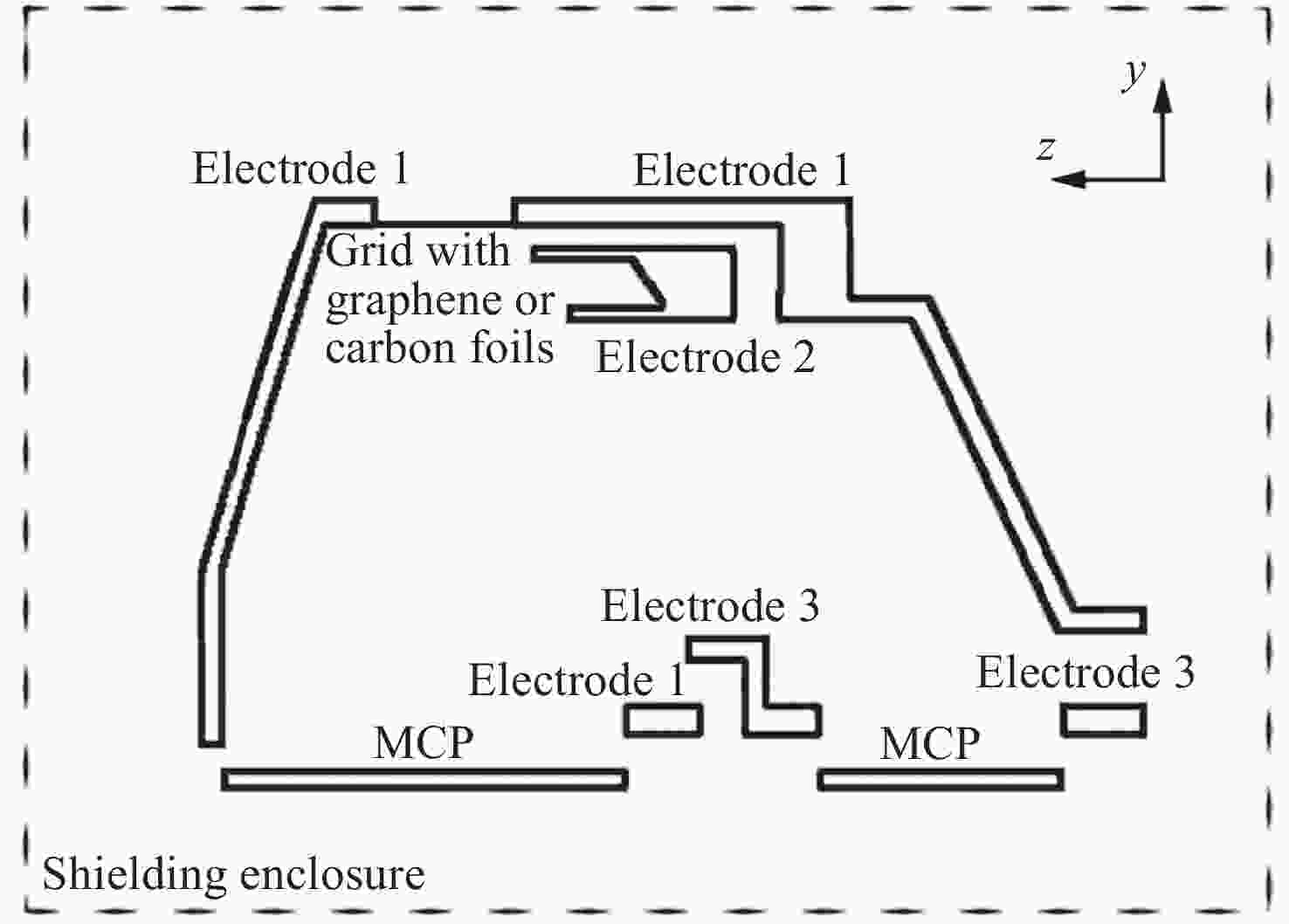
 下载:
下载:
